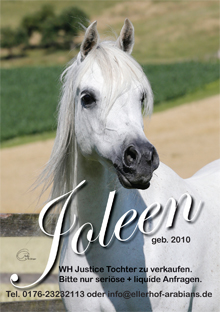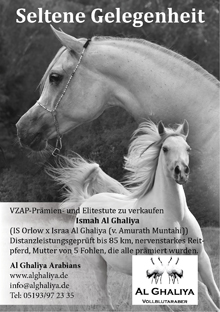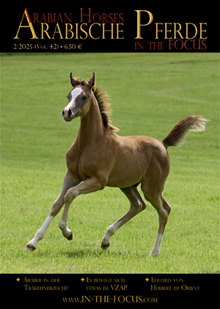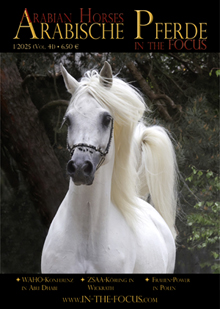–Opinion article-
To compare breeding animals and the consequent selection and awarding of the best is as old as selective breeding – over 200 years. The “ECAHO shows” also have their origins in the assessment and comparison of breeding stock. But today, these shows have moved far away from this original idea, as we will see.
The assessment of breeding animals depends primarily on the juding system in use and the judges. The judging system we chose will influence which type of winner we will see in the ring. And the hippological expertise, the experience and the integrity of the judges are crucial in any judging system. But it is precisely these points that are increasingly under dispute, which is why shows are becoming increasingly less important in our part of the world. In order to understand how we got into the current situation, we have to look at the basic ideas and basic structures on which our shows are built.
The judging systems
The way in which animals are selected has a decisive influence on the appearance of the respective breed. If the selection takes place exclusively on the racetrack, you will soon have “small English thoroughbreds”. If the selection takes place exclusively through beauty contests, sooner or later you will end up with caricatures of the actual species – this is no different with dogs and cats than with (Arabian) horses.
The ECAHO has been responsible for the shows, the judging systems used and the training of judges in Europe and the Middle East since the mid-1980s. Since its inception, it has preferred the 5-criteria / 10 or 20-point system (for the sake of simplicity, let’s stick with the 20-point system, although will be said also applies to the 10-point system), but also the comparative judging system popular in England is permitted at National Championships, as well as at C shows and lower categories. In principle, any judging system is permissible for these categories (e.g. also the 11-criteria / 10-point system of the Swiss stock show), as long as it is described precisely in the schedule. The point system is mandatory for A and title shows, and recommended for B shows – this primarily serves to standardize the international shows.
Originally, the points judging system was intended to judge against an ideal: the ideal Arabian horse should receive the maximum 20 points in all criteria and thus achieve a maximum of 100 points (breed standard). In contrast, with the comparative judging system, the horses are only compared with each other and then ranked.
The point system aims to achieve four things:
a) Each horse is assigned a (final) score, which provides a statement about its quality (deviation or conformity to the breed standard). At the same time, the final scores allow a more precise differentiation between the horses than the mere ranking does (example: the winner has 95 points, the second 94.5, the third 90 – so the winner and second place are closer in quality than the second and third place).
b) The owner should be able to use this differentiated assessment (5 criteria) to recognize where his horse’s strengths and weaknesses lie.
c) The final scores automatically rank the horses in a class (i.e. put them in an order).
d) The spectators – mostly owners, breeders or enthusiasts – have the feeling that they can better follow the judges’ thoughts by displaying the points awarded; the system appears more transparent, open and honest.
That’s the theory.
In practice, the points system suffers from several issues:
1) An objective evaluation is pretended (using numbers and decimals), although it is based on the subjective assessment of the judges.
Because the final scores are calculated to the hundredth behind the decimal point, the exhibitor is given the illusion of “accuracy,” which, however, does not exist due to the subjective nature of the grading. An objective evaluation occurs when something can be measured, for example the time of the winner in a race or how many poles fall in a show jumping course – this is not the case in conformation assessment. A conformation assessment is always based on the experience and training of the judges and their subjective taste.
2) The points system can be easily manipulated.
In practice, any judging system is only as good as its user (i.e. the judges), and in my opinion the points system is widely and systematically abused, even if, for the sake of simplicity, we assume no bribery, friendly service, hasty obedience, etc., is taking place… Misuse of the judging system also occurs when the judge identifies his “favorite” during the joint walking round and decides for himself: This horse must win! In order to increase a particular horse’s chances of winning, the judge can now give his favorite more points and/or his strongest competitor less – and the differences in quality between the two horses, expressed by points, will be greater than they actually are and the “favorite” is placed further ahead than he deserves when viewed soberly. With this “stroke of genius”, points a) and b) above, which speak for the points system, are reduced to absurdity.
Now, it is entirely human to choose your favorite in the common walking round, and perhaps the second and third, roughly defining the middle field and the end. Then when viewed individually, the order can change back and forth slightly. But you don’t need a points system for that; it would be much better done with a comparative scoring system – and more honest! The counter-argument for the comparative judging system is usually that if the exhibitor is not happy with the judge – because, for example, he breeds Egyptians, but the exhibitor breeds Russians – he will not show his horse at all. This is certainly true to a point, but there are also systems that allow several judges to judge comparatively. However, if only one judge judges, he must stand by what he decides and cannot “hide” in the group of 3-7 judges, i.e. he is solely responsible for the result. And it also speaks in favor of comparative judging that it is more in human nature to compare the horses that you see in front of you than to judge them against an “invisible” ideal. Here and there, however, at the end of the class you only have one ranking, because points a) and b) are reduced to absurdity in the points system and are not included in the comparative ranking system at all.
Countermeasures
The ECAHO also recognized that the points system is susceptible to manipulation by “judging up or down” individual favorites or competitors. As a countermeasure, deleting the highest and lowest scores was tried. But this means that the judges are “educated” not to award high or low scores, regardless of whether these are justified or not. No judge wants his scores to be constantly deleted, because who can judge from the outside whether it is a competent judge who gives a club foot a 14 or a corrupt judge who gets a competitor out of the way with a 14?
And that brings us to the “uniformity” of scores that no longer show any real differentiation. In fact, the scores usually range between 16-20 points, at top-class shows only between 18-20, and for legs, the scores are between 15-17 points. This has various causes:
a) Lack of self-confidence on the part of the judges to make the most of the scoring scale – no judge wants to be booed by the audience…
b) Lack of expertise on the part of the judges to correctly apply the scoring scale
c) The judges’ desire not to upset the exhibitor (and therefore the organizer) with low grades – after all, you want to be invited back…
d) Point inflation and the “scoring jam” at the upper end of the scale
e) Deleting the highest and lowest notes (as described above).
As a measure, the ECAHO has introduced half points for the large and important shows (A and higher), but this only worsens the effect, because now the hundredth after the decimal point decides between victory and defeat.
At big shows, organisers try to prevent the corruption that is always suspected behind closed doors by as large a panel of judges as possible. At the last World Championships in Qatar, 15 judges were invited who rotated through the classes without prior announcement in order to ensure as much as possible that they were not influenced “from outside”. But which image does this confirm to the outside world?
Weighting of individual parts
Another point of criticism of the points system is the weighting of the individual parts, which amounts to an overemphasis on “Type”. The five criteria are Type – Head & Neck – Topline/Body – Legs – Movements. In the ECAHO, “Type” is supposed to mean “breed type”, but in practice this is defined in an estimated 80% by the head or the “dish”. A “typey” horse has two chances of achieving high points (for the criteria “Type” and “Head & Neck”), whereas a horse with less type but with good movements only has one criterion in which it can score. This is intentional because many see the type as the most important unique selling point of the Arabian horse. But it is also the most subjective of all criteria, and therefore the least (objectively) attackable and most easily manipulated criterion!
Training and reality
If you read through the (new) “ECAHO Judges Training Manual 2023”, there is a lot of talk about what an Arabian horse should look like (https://issuu.com/ecaho/docs/ecaho_trainingmanual2023_issuu_digital). And of course the Arabian “type” is also covered in it. But the reader may be surprised that this is not 80% tied to the “Dish”! Here is an excerpt:
“Type is first and foremost the way we differentiate one breed from another. In the Arabian horse, Type takes an additional significance through the breeds natural qualities, its presence and flamboyance which have influenced painting, poetry and photography over the centuries. Nowadays, when assessing a horse, whilst we may keep the artist’s inspiration in mind, it is all the qualities behind the image that we are looking for:
– Pride of bearing, especially in the carriage of head, neck and tail
– Lightness, athleticism and freedom of movement
– Correct, sound conformation
– Exquisite modelling and dryness of the skeleton, especially the head
– Fine quality of skin and hair
– Temperament, people friendly and trainable
– Presence and charisma, the natural ability of the horse to project itself, the ‘look at me’ factor
“Type” is essential and the definition of “Type” has become standard, but it still remains highly subjective, and differences in preference are inevitable, even desirable. Over the years, different types within the breed have been recognised, based around different bloodlines or countries, however with the development of the universal show horse certain characteristics are being more highly emphasised than might have been the case in the past and those older types are being lost. It remains important that variations are appreciated provided they fall within the same broad concept of what constitutes the ideal…”.
As we can see from this description, the “type” criterion is only incidentally about the head, namely when it comes to the (proud) posture of the head or its dryness. This criterion is not about the dish or the profile – and yet I hardly know of any judge that gives the type a 20 but only 17 for head…
When it comes to the head it says:
„The head’s profile and shape from the side should be wedge shaped, with a dish or reasonably concave profile. A slightly bulging forehead (Jibbah) and a straight profile with refinement are also accepted. Viewed from the front there should be width between the eyes, which are set out from the head. The head should narrow towards the muzzle“.
And under the “undesirable characteristics” you can read (among others): “An extreme dish can affect air intake and result in misalignment of the teeth”. These explanations could also be expanded to include other critical points – topline, shoulders, legs – in today’s show horse breeding.
The problems are definitely recognized by ECAHO and its instructors and taken into account in teaching – but what happens then? A few years ago there was a judges’ seminar (compulsory every few years) in Aachen in connection with the ANC. A befriended judge who attended this seminar was thrilled that these critical points were addressed. After the show he was disappointed because none of the ANC judges who also attended the seminar had even begun to implement what was taught…
Influence on the breed
You used to hear arguments like: “I want to help breeders breed better horses,” or “I want to see as many horses as possible up close to further train my eyes,” or “I would like to find a stallion for my own stud and to attend shows is a great possibility”, when it comes to the motivation for becoming a judge. I hear these noble motifs less and less. Today – it seems to me – it’s more about luxury holidays and money, because in the Middle East show organisers pay up to €1000 per day at the big shows (and the shows last for 3 days…). If you then consider that there are judges who judge up to 13 ECAHO shows in the Middle East (figures from 2023), then that adds up to a pretty penny. We want to leave open what other reasons there could be for this high number of invitations to judges, as well as the question of whether this money is taxed…
So, if the horses and the breed are no longer the focus of interest of the judges, we don’t have to be surprised if the selection based on showing goes in the wrong direction. Maybe we should ask our judges, “Where do you see our breed and the show scene in five to ten years? And are you aware that it is you who shows the way?”
A judge must be aware that every time he gives a mark, he is also giving a vote for what the Arabian horse of the future will look like! Every time he gives a 20 for an extreme head, he encourages the breeder to breed even more extreme heads. Every time he gives an undifferentiated 15 for legs, he is telling the breeder that legs don’t matter. Every time he evaluates movement, even though the horse is just running in circles and is not taking two steps in a straight line, he is letting the handler know that he can get away with it.
Judges used to be authorities, but today they are viewed with suspicion. This loss of credibility is one of the reasons why the majority of breeders have left the show scene. Now, 17 million euros are to be distributed to horse owners and handlers for a new show series, the “Global Champions Arabians Tour”, which includes seven shows in the Middle East and Europe and ends with the World Championships in Paris in 2024. I fear, that this will not increase trust in the judges – quite the opposite. Where so much money is involved in a system with a subjective assessment for which the judge cannot be held accountable, the door is open to further abuse. Gudrun Waiditschka














